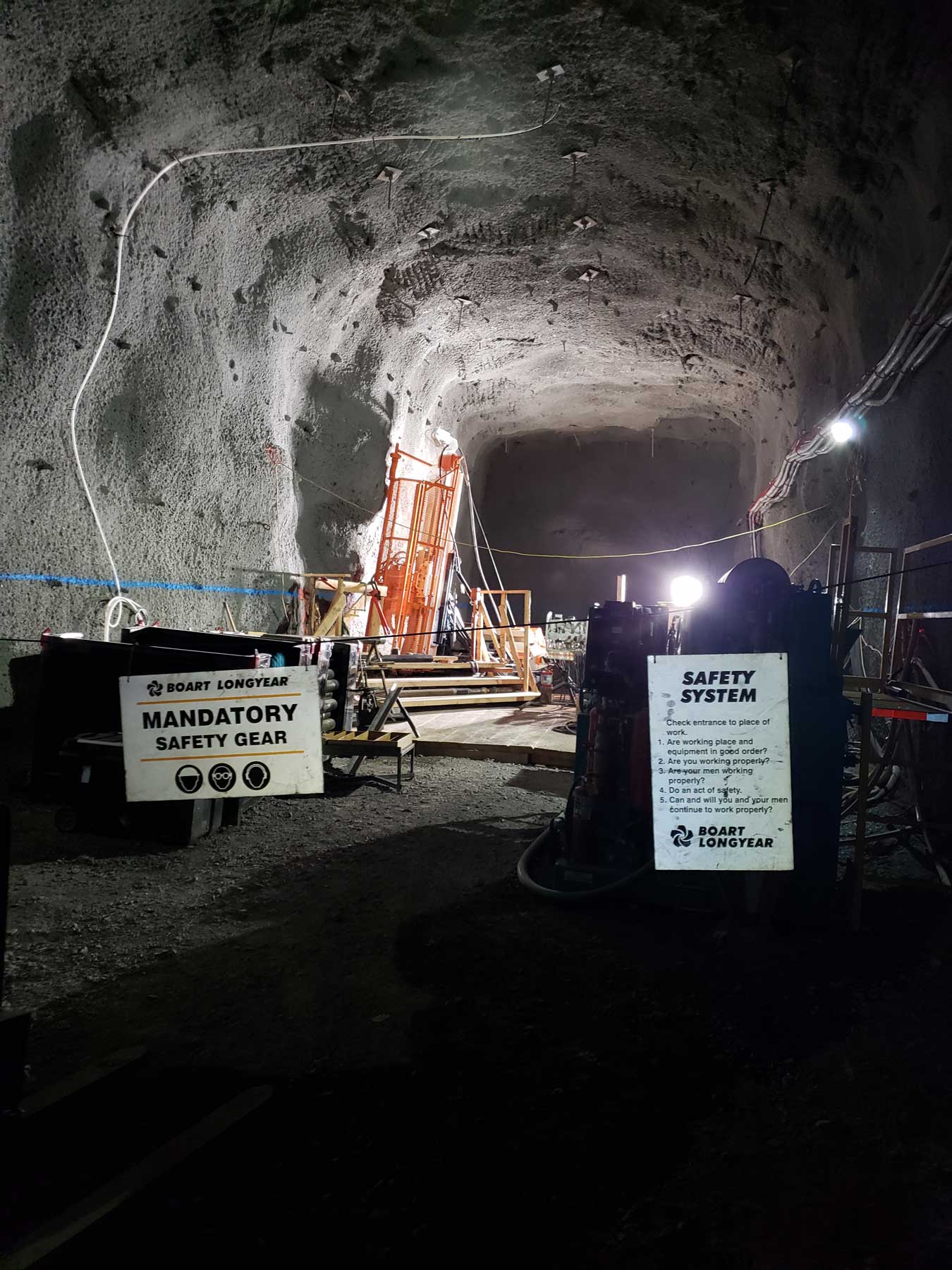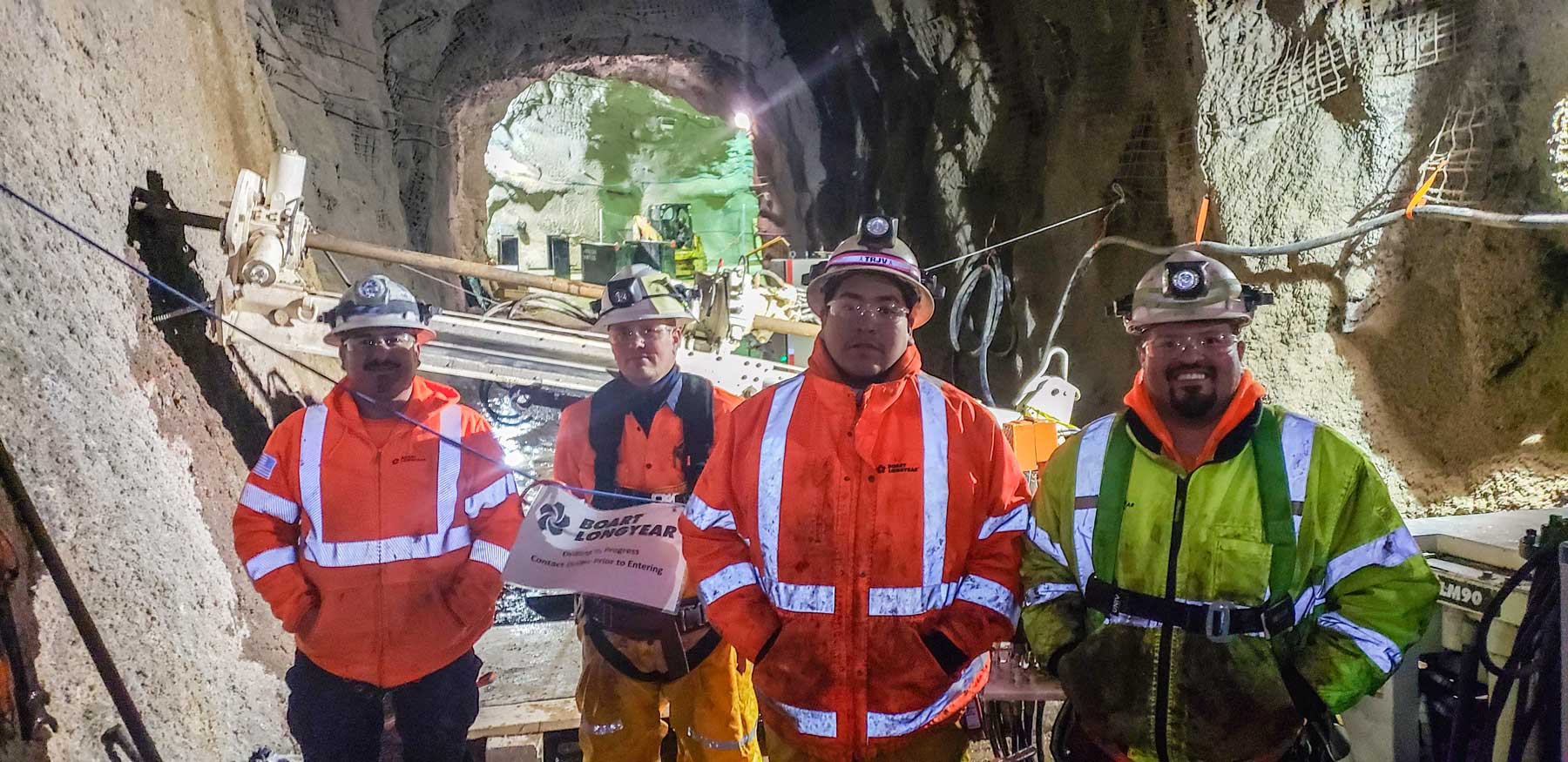EXPLORACIÓN
29 de enero de 2020
Explorando las posibilidades con la ayuda de maquinaria novedosa y equipos de trabajo capacitados
El trabajo como contratista para la extracción de muestras subterráneas en un sitio determinado no siempre resulta tal como se planificó.
En un proyecto en particular, Boart Longyear movilizó plataformas de extracción de muestras subterráneas a la mina de un cliente en los EE. UU.. En el lugar, la mina estaba enfrentando un gran problema de agua que hacía imposible completar la extracción de muestras subterráneas. Existían en la mina dos pozos ubicados en diferentes niveles, uno encima del otro. El pozo más profundo tenía bombas instaladas y estaba listo para bombear agua a la superficie. Sin embargo, el pozo superior se había inundado y no había bombas.
En lugar de intentar instalar bombas adicionales en el pozo vertical superior inundado para eliminar el agua, Boart Longyear movió sus equipos de perforación subterráneos hacia el pozo inferior y perforó una serie de orificios ascendentes en forma de abanico hacia el pozo inundado. La idea funcionó, utilizando efectivamente la gravedad para drenar el agua del pozo superior hacia el inferior donde las bombas pudieron mover el exceso de agua a la superficie. La mina pudo continuar las operaciones en el pozo superior y Boart Longyear pudo también comenzar la perforación de exploración de extracción de muestras.
En otro proyecto, se pensó que la mina estaba seca. Después de que comenzó la exploración subterránea, la cuadrilla de Boart Longyear se encontró inesperadamente con mucha agua. El grupo de trabajadores pudo idear un plan para controlar el agua y completar la perforación de exploración. Después de aplicar lechada a presión en una cubierta de cemento, se instaló con éxito un dispositivo de prevención de reventones (BOP, que se usa para sellar, controlar y monitorear el agua para evitar reventones y la liberación descontrolada de agua a alta presión) junto con una empaquetadura de rocas para mantener el agua contenida. En la mayoría de los casos en que se encuentra esa cantidad de agua los resultados son bastante distintos. Todos han experimentado, o al menos saben de alguien a quien le ha pasado algo similar, esa situación en la que un gran volumen de agua expulsa todas las herramientas del agujero, lo que resulta en un verdadero caos.
Equipos de perforación subterránea en proyectos de superficie
Otros ejemplos de desafíos inesperados incluyen soluciones creativas donde se utilizan los equipos subterráneos diseñados por Boart Longyear en la superficie. La División de Perforación Subterránea del área de Servicios de Perforación movilizó plataformas a un sitio de mina donde un retraso en la exploración subterránea de perforación con diamantina hizo que los equipos de perforación subterránea estuvieran inactivos en la superficie. Alguien vio los equipos de perforación subterránea inactivos y preguntó si era posible perforar con ellos agujeros en ángulo plano en la superficie. Aceptando el desafío, los equipos de perforación subterráneos han estado perforando estos pozos bajos y de ángulo plano desde entonces.
El sitio de la mina tiene un permiso limitado de intervención de la superficie, lo que significa que para alcanzar las formaciones geológicas fuera del área autorizada por el permiso, la división de Perforación Subterránea de Boart Longyear está operando plataformas subterráneas en la superficie para perforar agujeros planos y de ángulo bajo que las plataformas de superficie a menudo no pueden alcanzar debido a la gran altura de los mástiles que deben ir montados sobre camiones.
Los equipos de perforación subterránea pueden perforar en ángulos bajos desde -40 grados hasta planos. Perforan debajo del área donde el cliente minero no puede alterar la superficie. Esto significa que el núcleo de exploración puede seguir las vetas de mineral sin alterar la superficie y perforar debajo del área fuera del permiso de intervención.
Los pozos son de 2600 pies a 2700 pies (792.48 ma 822.96 m) en un ángulo de -40 a -12 grados. Boart Longyear tiene las herramientas y la experiencia para ese tipo de perforación, pero no pudo realizar el trabajo con plataformas de superficie porque cuando se configura plano, estará a 12 pies (3,66 m) del suelo porque el mástil está muy arriba en un camión Con las plataformas subterráneas, se construyó una plataforma o plataforma de trabajo, que permitió al equipo trabajar cerca de ellos.
Una flota versátil y única.
La División de perforación subterránea de Boart Longyear Drilling Services en los EE. UU. opera todos los equipos LM ™ y MDR diseñados y fabricados por Boart Longyear. La serie de plataformas LM presenta componentes fácilmente intercambiables, lo que permite limitaciones de espacio sin sacrificar los requisitos de profundidad. Estos equipos de extracción de muestras modulares ofrecen un acceso más fácil en espacios subterráneos estrechos y movilidad para movimientos más fáciles de hoyo a hoyo o de pozo a pozo. Las herramientas patentadas de Boart Longyear ofrecen agujeros ascendentes más seguros y más eficientes en cualquier ángulo.
Los equipos de perforación subterránea de la flota de los Servicios de Perforación se modifican y personalizan, en comparación con los equipos de perforación subterránea Boart Longyear disponibles comercialmente. Por ejemplo, el LM ™ 90 está mejorado con un motor de 150 caballos de fuerza en lugar del típico motor de 90 caballos de fuerza e incluye modificaciones adicionales para aumentar la capacidad de profundidad y el tamaño del núcleo.
La División de Perforación Subterránea de Servicios de Perforación tiene la experiencia y los conocimientos técnicos para perforar galerías de desagüe, perforaciones geotécnicas, investigaciones de túneles, servicios de aplicación de lechada y perforaciones de servicios públicos. La división también tiene experiencia en perforaciones de overcore para medir el estrés in situ. La perforación de overcore implica perforar un agujero a una cierta profundidad con una broca de diámetro EX o AX de pequeño diámetro, colocar una sonda para medir los datos de respuesta de deformación y luego usar una resina especial para pegar la sonda en su lugar. Después de perforar un núcleo de mayor diámetro para recuperar la sonda, la muestra de núcleo y la sonda se usan para probar la formación de roca y planificar el soporte en el suelo. Este método se usa a menudo, tanto en túneles horizontales como en pozos verticales, para medir la cantidad de tensión que puede soportar la roca.
Perforación horizontal para desagüe
Otra aplicación única de las maquinarias de perforación subterránea y sus cuadrillas de trabajo es la perforación en la superficie de paredes altas con fines de desagüe. Las perforaciones planas y hasta casi horizontales, desde 10 grados hasta 10 grados invertidos, se pueden utilizar para crear perforaciones de drenaje automático en paredes altas. La lechada a presión en una cubierta de collar de cemento evita que el orificio se colapse y se puede usar con una válvula BOP en caso de que el cliente minero quiera encerrar el agua en la formación rocosa.
Para mantener la integridad del orificio, la instalación de cloruro de polivinilo ranurado (PVC) evita que el orificio se colapse. Si se atraviesa una zona fracturada, cuando el agua comienza a fluir, el agujero se puede cerrar después de un par de meses. El PVC mantiene el agujero abierto y el agua corriendo.
El beneficio de usar equipos de perforacion subterránea para este tipo de perforación es la diferencia entre las grandes plataformas rotativas que producen muestras de virutas y usan una menor rotación por minuto (rpm) y un mayor torque, mientras que el equipo de extracción funciona a mayores rpm y menor torque. Los equipos para extracción subterránea de núcleos perforan más lento, más recto y más profundo y recogen el núcleo para su análisis posterior.
Los geólogos pueden usar muestras de núcleo de perforación horizontal en una pared alta para buscar fracturas, fallas y oxidación (para identificar zonas portadoras de agua). Estas también se pueden identificar en muestras de chips con equipos de perforación rotativos, pero es más difícil verlos de esa manera. Una muestra de núcleo proporciona una mejor vista física de la formación rocosa. La perforación de paredes altas con equipos de perforación subterránea cumple dos objetivos con un solo pozo: desagüe y obtención de muestras de núcleo para analizar fracturas, fallas y oxidación.
LM ™ 90 con marco de alimentación personalizado. Perforadores expertos de izquierda a derecha: John Sanchez, Jimmie Maggard, Marcus Woody y Sal Renteria.
Los verdaderos héroes
Ya sea que se trate de un proyecto de perforación subterránea o una aplicación de superficie para plataformas de perforación subterráneas, los equipos de perforación son los verdaderos héroes en Boart Longyear. Tienen recursos de gran alcance (global) para encontrar soluciones únicas e inventivas para desafíos de perforación complejos, técnicos y, a veces, inmensos, y no tienen miedo de hacer preguntas.
Más que una actitud positiva, una gran ética de trabajo, diversas habilidades, vasta experiencia, conocimiento técnico y un compromiso con la seguridad y el éxito de cada cliente, hacen el trabajo. Los perforadores, asistentes de perforación, soldadores, mecánicos, supervisores y todo el personal de apoyo viajan para trabajar en lugares remotos, en todo tipo de clima, ambientes y altitudes que son un desafío, además de tener que pasar mucho tiempo lejos de sus familias. El trabajo es extenuante, implica una amplia capacitación y requiere toda su atención por razones de seguridad.
En Boart Longyear, trabajar de manera segura, es responsabilidad de todos.
Denis Despres, Director de Operaciones
Todos estos héroes reales contribuyeron al último logro de seguridad de Boart Longyear de 10 millones de horas-hombre y un año de tiempo libre sin lesiones. ¡Felicitaciones a todos los equipos de perforación y al personal de apoyo por este logro en toda la empresa! Denis Despres, Director de Operaciones declaró: "A nivel de sitio, valoramos los procedimientos cotidianos de las reuniones de información estandarizadas previas al inicio que se centran en las tareas laborales diarias y los peligros y riesgos asociados, nuestro sistema de gestión de datos en línea, incluida la aplicación móvil del sistema, y el equipo diario y las evaluaciones de riesgos a nivel de campo individuales. En Boart Longyear, es responsabilidad de todos trabajar de manera segura ".
Publicado originalmente en Número 11 de la revista Coring, noviembre de 2019
SUSCRÍBASE AL BOLETÍN INSITE
Si quiere recibir artículos como éste y más información, suscríbase al boletín mensual INSITE
REGÍSTRESE AQUÍ
[pardot-form height="770" id="3468" title="INSITE Mailing list"]
DISCUSIÓN
-
Your next level awaits — find it with premium cannabis from ObtainHigh.com!





